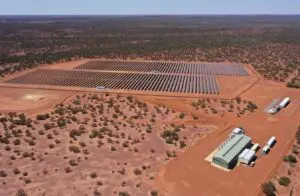A lack of clear policy and planning around the use of solar energy for agriculture has left Australia lagging in the field of agrivoltaics, according to a new report.
The report “Pursuing an Agrivoltaic future in Australia” saw dozens of farmers, solar developers and government representatives consulted to work out what was needed to improve uptake.
Agrivoltaics is the practice of co-locating agricultural production systems with solar development.
The report identified knowledge gaps as well as technical and economic impediments that have hindered the uptake of agrivoltaics.
“Adoption has been very slow in Australia, we just haven’t really grasped the opportunities ahead for us,” report author Karin Stark said.
Australia has been left behind other parts of the world like Japan, France and Germany because of a lack of understanding, she said.
“Japan grows 120 different crops under solar panels, that’s pretty extraordinary, we need research for Australia,” Ms Stark said.
Overseas research has shown advantages include increased soil moisture, reduced irrigation demands and protection from excessive heat, frost and hail.
NSW farmers Libby and Peter Skipworth are exploring what crops could be grown under solar panels to give them more control in a changing climate.
“Going into a semi protected cropping system gives us a little more control over that variability,” Mrs Skipworth said.
At their property at Lake Cargelligo in central NSW, they’re looking at leasing a portion of their land to a local company, who would erect solar panels with crops then to be grown underneath.
“We’re looking at this as an opportunity to not only create some diversified revenue stream to our business, but also hopefully create jobs and opportunities for local people,” she said.
And Mrs Skipworth hopes the report will help to clear hurdles for other farmers.
“Because this is fairly new, it’s very challenging to find meaningful information on agrivoltaics.”
The report highlighted the need in Australia for more research and demonstration sites, supportive policy, and knowledge sharing.
Recommendations include calls for an injection of cash from the Australian government to develop guidelines for developers, operators, and farmers.
AAP
See also a recent op-ed by Karin Stark: Renewables and farmers: Is this golden opportunity about to slip through our fingers?










